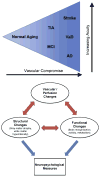Effects of hypoperfusion in Alzheimer's disease
- PMID: 21971457
- PMCID: PMC3303148
- DOI: 10.3233/JAD-2011-0010
Effects of hypoperfusion in Alzheimer's disease
Abstract
The role of hypoperfusion in Alzheimer's disease (AD) is a vital component to understanding the pathogenesis of this disease. Disrupted perfusion is not only evident throughout disease manifestation, it is also demonstrated during the pre-clinical phase of AD (i.e., mild cognitive impairment) as well as in cognitively healthy persons at high-risk for developing AD due to family history or genetic factors. Studies have used a variety of imaging modalities (e.g., SPECT, MRI, PET) to investigate AD, but with its recent technological advancements and non-invasive use of blood water as an endogenous tracer, arterial spin labeling (ASL) MRI has become an imaging technique of growing popularity. Through numerous ASL studies, it is now known that AD is associated with both global and regional cerebral hypoperfusion and that there is considerable overlap between the regions implicated in the disease state (consistently reported in precuneus/posterior cingulate and lateral parietal cortex) and those implicated in disease risk. Debate exists as to whether decreased blood flow in AD is a cause or consequence of the disease. Nonetheless, hypoperfusion in AD is associated with both structural and functional changes in the brain and offers a promising putative biomarker that could potentially identify AD in its pre-clinical state and be used to explore treatments to prevent, or at least slow, the progression of the disease. Finally, given that perfusion is a vascular phenomenon, we provide insights from a vascular lesion model (i.e., stroke) and illustrate the influence of disrupted perfusion on brain structure and function and, ultimately, cognition in AD.
Figures

References
-
- Mazza M, Marano G, Traversi G, Bria P, Mazza S. Primary cerebral blood flow deficiency and Alzheimer’s disease: shadows and lights. J Alzheimers Dis. 2011;23:375–389. - PubMed
-
- Dede DS, Yavuz B, Yavuz BB, Cankurtaran M, Halil M, Ulger Z, Cankurtaran ES, Aytemir K, Kabakci G, Ariogul S. Assessment of endothelial function in Alzheimer’s disease: is Alzheimer’s disease a vascular disease? J Am Geriatr Soc. 2007;55:1613–1617. - PubMed
-
- Carlsson CM, Gleason CE, Puglielli L, Asthana S. Chapter 65. Dementia Including Alzheimer’s Disease. In: Halter JB, Ouslander JG, Tinetti ME, Studenski S, High KP, Asthana S, editors. Hazzard’s Geriatric Medicine and Gerontology. McGraw-Hill Medical; New York: 2009. pp. 797–811.
Publication types
MeSH terms
Substances
Grants and funding
LinkOut - more resources
Full Text Sources
Medical

